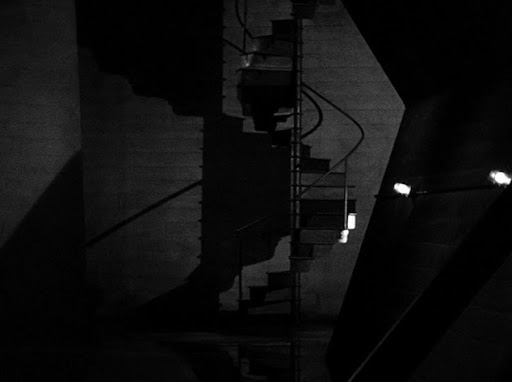The Black Cat (1934) was a film directed by then-unknown émigré filmmaker Edgar G. Ulmer in Universal Studios.
The titles say the source of the picture is the Edgar Allan Poe story, but "it is not a story you can dramatize," said Ulmer frankly. So he moves freely with the new ideas about the plot, characters and their relations.
An important source of inspiration for Ulmer was a true story he had heard while working on The Golem (1920). "Doumond was a French fortress the Germans had shelled to pieces during World War I; there were some survivors who didn't come out for years," explained Ulmer in a 1970 interview with Peter Bogdanovich. "And the commander was a strange Euripides figure who went crazy three years later, when he was brought back to Paris, because he had walked on that mountain of bodies."
The shooting was done in two weeks and the budget was at a third of what the studio had spent on the other hits like Dracula (1931) or Frankenstein (1931).
Since this was the first screen pairing of Karloff and Lugosi, the confrontation of two horror masters is one of the key elements of the picture that Ulmer emphasizes it, beautifully.
A masterpiece of construction, build upon the ruins of the masterpiece of deconstruction, the masterpiece of murder.”
This is one the most memorable lines in history of motion pictures and it would be heard from the lips of the living example of “masterpiece of deconstruction”, no one but Bela Lugosi, referring to the architectural work of his enemy Poelzig, in The Black Cat.
“This is a very interesting house you have here Poelzig, has an atmosphere, kind of…” says the trapped guest of the house, Peter Alison, but he couldn’t find the right words to sum up his feelings. The creeping master of the house, Poelzig, complete him with a line that could be read as Edgar Ulmer’s statement about the modern architecture in his great “masterpiece of construction,” The Black Cat:
“…It is indeed hard to describe. It's as hard to describe as life, or death. It may be the atmosphere of death.”
Who is Poelzig and how a B director, like Ulmer, could present such a precise cinematic view of the modern world?
Hans Poelzig (1869-1936) was a German architect. In the early 1920s he was a respected professor of architecture in Berlin. His first designs show the influence of late classicism, Gothic style, regional traditions, art nouveau and American's new office building methods. As a member of the avant-garde architectural society Der Ring, Poelzig played a prominent role in the battle over the introduction of modern architecture in the 1920s.
He designed his masterpiece, Berlin's Große Schauspielhaus theatre interior design for Germany's most celebrated stage director Max Reinhardt, in 1919.
Poelzig's work developed through Expressionism and the New Objectivity in the mid-1920s before arriving at a more conventional, economical style.
He died on 14 June 1936 shortly before his planned emigration to Turkey.
One of the most important stages of his life was designing the vast architectural set for the 1920 UFA film production of The Golem. In the meantime and during the production Ulmer, a set designer, was introduced to the master architect by working under his guidance. Quickly Poelzig became Ulmer’s mentor, and when he found a chance to direct his first notable film in U. S., he returned the favor by naming the architect-villain character “Hjalmar Poelzig.”
This film shows clearly that Ulmer, via real Poelzig, was well aware of the Gothic art's abrupt impact on the audience/spectator, and he was a genius in uniting this kind of imagery with the composure of modern architecture. Most of the time there is a tense interaction between the architecture and the way Ulmer uses his camera. The Gothic compositions have been used as an assault to the cleanness of the modern interiors and the simplicity of concrete walls. In opposite, the simple compositions utilize for the most expressionistic scenes, like near-the-end satanic ceremony. It seems like the image and architecture are always balancing the brutality of the actions with the icy feeling of the atmosphere.
In Black Cat a modern building is replaced by the old Gothic castle with replete of strange decorative things and dusty furniture. There is no sign of cobwebs, candle sticks or creaky doors. Instead of those 19-century horror elements we see modern furniture and a house that really belongs to the new age. But the horrors are almost the same and the wonder is how Ulmer turns modern spaces to another source of abomination. The optimism of the first modern architecture movement has gone from the images and the devilish nature of gods and monsters (a favorite expressionist's theme) has conquered the space.
Recently I was revisiting The Mask of Fu Manchu -another satanic role for Karloff - and I was moved by the modern\minimalist design of the torture chambers and the similarity between this decors and Black Cat’s. But the work of Ulmer is more stylized in every way. He has stylized even the most ordinary moments of the film. His compositions are restless, and they deliver this feeling to audiences, too.

 modern building is replaced by the old gothic castle
modern building is replaced by the old gothic castle






The architecture of the Poelzig home is unexpected and delivers a chilling atmosphere. Just watched the film and enjoyed how the set uniquely contributed to the mise en scene.
ReplyDeleteIndeed, the house was the star of this movie and lugosi & karloff are perfect together. Ulmer hit the mark on modern creepiness. 1934? Way ahead of its time. Classic.
ReplyDeleteThis comment has been removed by the author.
ReplyDeleteI love the house in this film but what / where is it? Just stage-set?
ReplyDeleteJust movie sets built in the studio.
Delete